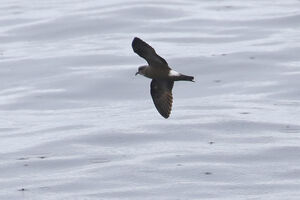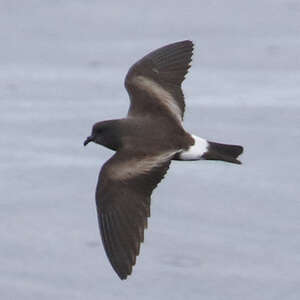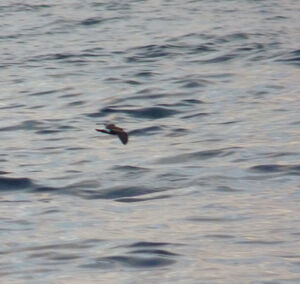Monteiro's Storm Petrel
Hydrobates monteiroi - Océanite de Monteiro
Identification
Monteiro's Storm Petrel is a lookalike of the Castro's Storm Petrel from which it cannot be safely distinguished in the field. It was only very recently, in 2008, that it was specifically separated from the latter on the basis of morphometric, biological and ecological differences. For example, its vocalizations are different and it does not respond to playback of the Castro's Storm Petrel's song.
It is a bit smaller than the latter, with comparatively longer tail, but the differences are slight and not appreciable in the field. Adult plumage is sooty brown and appears black at a distance and in poor light. In morning or evening light, the brown can warm up enough to acquire an artificial russet tone. In aerial view, the wing is barred diagonally at the wrist by a whitish beige band that starts from the greater coverts and goes to the tertials, passing through the base of the secondaries and is well visible in the bird in flight. But what can best be seen is the band of pure white from the post-rump and upper tail-coverts, except for the longest post-tail-coverts which have the black tail tone, and that continues laterally on the back of the flanks and is well perceptible in lateral view. The black tail is markedly forked and does not exceed the legs.
In underside view, the bird is entirely sooty brown with the inner underwing coverts slightly paler and usually with white visible at the back of the flanks under usually prevailing conditions in high seas observations.
Subspecific information monotypic species
Foreign names
- Océanite de Monteiro,
- Paíño de Monteiro,
- painho-dos-açores,
- Azorenwellenläufer,
- Monteiro's Stormvogeltje,
- Uccello delle tempeste di Monteiro,
- monteirostormsvala,
- Asorstormsvale,
- víchrovníček azorský,
- buřňáček azorský,
- Azorer-stormsvale,
- azorienkeiju,
- ocell de tempesta de Monteiro,
- nawałnik azorski,
- Azoru vētrasputns,
- Азорская качурка,
- モンテーロウミツバメ,
- 蒙氏叉尾海燕,
- azorstormsvala,
- 蒙特婁氏叉尾海燕,
Voice song and call
Habitat
Monteiro's Storm Petrel is pelagic, like all storm petrels, and only comes ashore to reproduce. It then chooses rocky parts of nearby islands rather than the coast itself, which allow the establishment of burrows for nesting.
Behaviour character trait
The only opportunities to observe this pelagic species, which only approaches the coasts at night, are during targeted research and observation trips at sea. However, the limited size of its population and the immensity of the favourable marine areas make the chance of seeing it very slim. This can be remedied and it can be attracted by using appealing odour products specifically for it, known as chumming by Anglo-Saxons. Chum is made up of fish offal and blood thrown into the water which produces scents that attract pelagic birds that have a smell, as well as probably aquatic predators such as sharks. Under these conditions, you may be lucky enough to have ten or more Monteiro's Storm Petrels around you, although the species is not naturally gregarious. Its flight is then quite rapid at a low height over the water, slightly bouncing, with ample wing beats and sudden U-turns that indicate its search for food. It does not get close to dry land until twilight and waits until nightfall to reach its nesting burrows.
Dietfeeding habits
The diet of Monteiro's Storm Petrel is very little known, just like the rest of its biology. The species is believed to feed on small fish and squid.
Reproduction nesting
Little is known about the reproduction of Monteiro's Storm Petrel due to its recent elevation to species rank, but studies are underway to identify the main reproductive parameters. The nest is established at the bottom of a burrow made by it and it also readily accepts artificial burrows. The female only lays a white egg of 10th of a gram which she incubates for about a month. The rearing of the chick lasts for about 2 months. Productivity is very low. It has been estimated at 0.16 chicks per nesting couple in the early 2000s. This is certainly compensated by a high adult survival rate as is the case with other pelagic birds.
Geographic range
Threats - protection
IUCN conservation status
concern
in the Wild
threatened
evaluated
Due to its very restricted distribution area and its weak nesting population, estimated at 250-300 couples in the early 2000s, Monteiro's Storm Petrel has been classified as vulnerable by BirdLife International. Several negative elements are hindering its reproductive success. These are human visiting of the reproduction islets, competition for favourable terriers, which are naturally scarce, and predation. The first measure that was taken and that was necessary was to reserve the islets. Currently, only researchers with research programmes can access them. The second measure taken in the mid-2000s was to create artificial terriers. The results were immediately encouraging with a clearly increased reproductive success showing that it was an important parameter. Lastly, predation of chicks by land predators is more difficult to control. The islets are theoretically free of rats, but the risk is permanent due to the proximity of islets of the coast. Permanent surveillance is necessary. Another problem comes from the presence on the main reproduction islet of a lizard originating from Madeira, Lacerta dugesi, accidentally introduced to the Azores and dozens of which have been seen in groups attacking a storm petrel chick. Other cases of predation are probably attributed to them. Finally, the adults are exposed to the nocturnal predation of the local medium-sized owl when they return to their terriers at night and the importance of this predation is not to be neglected. A study has shown that more than 40 adults can be killed each year by this raptor. This is even more consequential as the adult survival rate is the most important demographic parameter. Nevertheless, this natural predation can be considered bearable insofar as one can act on the other causes of mortality and attenuate its effects.
Sources of information
- IOC World Bird List (v15.1), Gill, F and D Donsker (Eds). 2025-12-07.
- Avibase, Lepage Denis
- HBW Alive,
Other sources of interest
 Specification sheet created on
28/07/2023 by Jean François
Specification sheet created on
28/07/2023 by Jean FrançoisTranslation by AI Oiseaux.net
© 1996-2026 Oiseaux.net
- Accipitriformes
- Aegotheliformes
- Anseriformes
- Apodiformes
- Apterygiformes
- Bucerotiformes
- Caprimulgiformes
- Cariamiformes
- Casuariiformes
- Charadriiformes
- Ciconiiformes
- Coliiformes
- Columbiformes
- Coraciiformes
- Cuculiformes
- Eurypygiformes
- Falconiformes
- Galliformes
- Gaviiformes
- Gruiformes
- Leptosomiformes
- Mesitornithiformes
- Musophagiformes
- Nyctibiiformes
- Opisthocomiformes
- Otidiformes
- Passeriformes
- Pelecaniformes
- Phaethontiformes
- Phoenicopteriformes
- Piciformes
- Podargiformes
- Podicipediformes
- Procellariiformes
- Psittaciformes
- Pterocliformes
- Rheiformes
- Sphenisciformes
- Steatornithiformes
- Strigiformes
- Struthioniformes
- Suliformes
- Tinamiformes
- Trogoniformes





